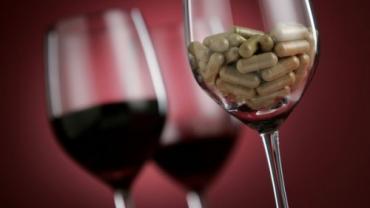
Resveratrol is a naturally occurring phenolic compound found in over 70 plant species which include nuts grapes pine trees and certain vines as well as in red wine. It is found in significant amounts in the Japanese knotweed plant. This plant is the most common source of resveratrol for human supplementation which is used to protect against environmental stresses including attack by pathogens such as bacteria or fungi.
A substantial amount of media attention and subsequent scientific inquiry has been devoted in recent years toward resveratrol for its potential health benefits in humans. This is due to the discovery of the "French paradox the finding that coronary heart disease mortality in France is lower than that observed in other industrialized countries with a similar risk factor profile due to the frequent consumption of red wine.
Since 2003 when the first study was performed on a species of yeast (and since then other species of living organisms) groups of scientists have found that resveratrol has potential life-extending and health-promoting properties. Researchers have found that resveratrol's possible life-lengthening characteristics are due to the polyphenol's ability to act like many plant-based compounds as a gene activator. The gene in question is the sirtuin 1 gene which when activated among other things increases mitochondrial biogenesis and improves mitochondrial function. This may explain its life-enhancing benefits.
Improvement in mitochondrial function by resveratrol ingestion may also be responsible for its demonstrated ability to improve exercise endurance in animal experiments. For obvious reasons including the enormous energy requirements of both skeletal and cardiac muscle cells both tissue types are particularly high in mitochondria. Improving fatty acid utilization a primary fuel for mitochondrial energy production had a direct benefit in improving physical performance of the study animals which were supplemented with resveratrol.
NADPH oxidase is a major cause of atherosclerosis through its generation of superoxide an oxidative molecule used by neutrophils and macrophages to fight and kill bacteria and pathological fungi. These oxidative molecules activate an enzyme that makes macrophages which when containing cholesterol form foam cells and adhere to the artery wall. An imbalance in favor of reactive oxygen species production is a major cause of atherosclerosis. Resveratrol again through the activation of the sirtuin 1 gene inhibits NADPH oxidase production decreasing the risk of developing atherosclerosis which many describe as a sign of vascular aging. Additionally mitochondria naturally produce hydrogen peroxide as a consequence of their activity. It is thought that this oxidative compound sets in motion an inflammatory cascade which in a vicious circle up-regulates NADPH oxidase activity. Resveratrol will also act as an anti-inflammatory agent inhibiting activation of TNF and NF and through this mechanism inhibit NADPH oxide activity.
Another example of resveratrol's possible anti-aging potential isseen in animal models of neurodegeneration brain aging and deficits in cognition and memory. Here resveratrol demonstrates its same role of sirtuin 1 activation as well as its antioxidative and antiinflammatory characteristics while also inhibiting cellular apoptosis. This shows resveratrol's promise in brain and neurologically oriented deficit conditions such as Alzheimer's Parkinson's and ALS.
In the next blog we will explore some of the more esoteric clinical properties of resveratrol that will present a more complete picture of the utility of this fascinating polyphenol.
by Michael Fuhrman D.C.